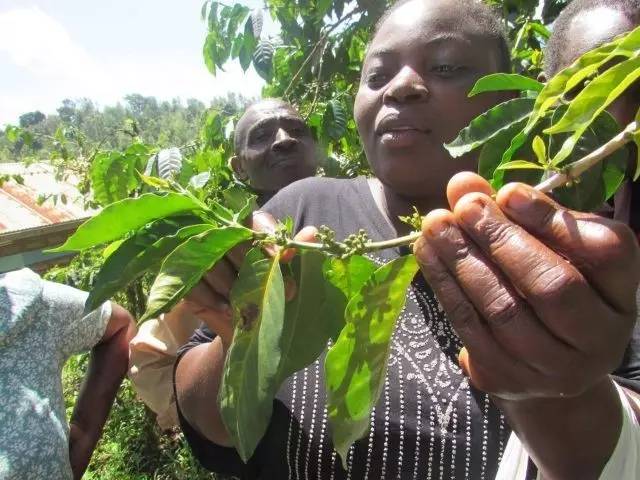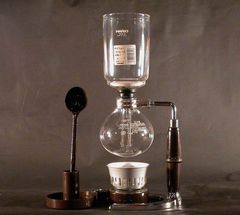Flavor roasting and production of Kenyan coffee beans
Pay attention to coffee reviews (Weixin Official Accounts vdailycom ) and find a beautiful cafe to open your own shop
Almost all boutique cafes serve Kenyan coffee, and almost all boutique coffee roasters roast Kenyan coffee, which enjoys a worldwide reputation. Why is that? We need to know more about Kenyan coffee.
Kenyan coffee flavor
Flavor complex/complex, fruity tonality, clear acidity, high body, distinctive aroma.
Kenya has six main producing areas: Central (Mt.Kenya, the Aberdare mountain range), Western (Kisij,Nyanza,Bungoma), Great Rift Valley (Nakuru ,Kericho), Eastern (Machakos,Embu,Meru), Coastal (Taita hills).
Each region has its own climate and growing environment, and there are many micro-batches in each region.
In addition, Kenya coffee varieties (varietals), of which SL-28,SL-34 belong to special varieties rarely cultivated outside Kenya. SL-28,SL-34 are planted at high altitude and complex flavors are their representative characteristics. In addition, K7(variety) is widely planted in low altitude areas and has strong drought resistance. Other famous Kenyan coffee varieties are-Batian,R11, which come from laboratories and are resistant to pests and diseases.
Kenya coffee classification: AA,AB,C indicates the size of the coffee bean, PB round beans (peaberry-coffee berries contain only one round coffee seed, not two), E indicates elephant beans, TT indicates low-density coffee beans.
Here's Kenneth Davids 'review of Kenyan coffee in Roast Magazine's May-6, 2017,"coffee review" section.
Kenya Othaya Bakers States Coffee & Mercantile| Martinez, California Origin Nyeri growing region, south-central Kenya Roasting Degree Light (Whole Bean 56/Powder 78)
Humid aroma 9 Acidity 9 Body 8 Flavor 9 Aftertaste 8
8ounces sold for $10. Produced by Othava Farmers Cooperative. The coffee variety is ruiru11, a hybrid of SL-28 and SL-34. Despite the opacity of the Kenyan government's coffee policy, the urbanisation of local coffee plantations and the vagaries of climate, Kenya's sophisticated auction system continues to produce the finest coffee in the world. States Coffee was founded by baker Keith Gehrke in 2015 and includes baking, Cafe operations, and craft art manufacturing.
Blind Test: Intense aroma, sweet herbal aromas, honey, mida aromas, cocoa, blackcurrant, almond. Acidity, lively, delicate and smooth taste. Almond and mida floral notes run through the finish. Classic Kenyan coffee, sweet, sour and aromatic, with floral notes of herbal plants and distinct berry flavours.
Roaster> Proster THCR-03 Roaster Notes> I usually reduce the heat to allow the coffee to slide naturally after the first explosion, but when roasting this Kenya, I will maintain a steady heat and roasting temperature after the first explosion in order to create the acidity and sweetness of this coffee. Keith Gehrke
Kenya coffee production methods
Kenya has approximately 700,000 coffee producers/growers, most of which are planted at a density of-1320 coffee trees per acre, and coffee is picked and processed manually.
Coffee is harvested twice a year, from April to June; October to December (sometimes continuing into January), and the beginning and end of the harvest depends on factors such as the region, the climate of the year, and the elevation of the plantation.
Coffee producers generally do not go it alone, but rather co-operatives, which help to improve consistency and stability of coffee quality.

Kenyan coffee processing
There are generally two ways to treat: washing and sun. Careful control of coffee processing can provide coffee quality. Take FTOK(made up of 12 cooperatives) as an example-coffee berries are sent to the cooperatives every Tuesday by farmers, the beans are peeled and pulped at the cooperatives, fermentation begins 72 hours later, fermentation lasts 72 hours, followed by drying.
Washing is the most common treatment in Kenya, but sun treatment is also used in the central region to process low-density coffee beans. Compared with washing treatment, solarization treatment requires greater investment, higher time and labor costs, and higher difficulty in quality control.
Kenya's coffee trade and production patterns are different from those of American and Asian producing countries. In Kenya, the government has great control over the coffee trade, and the government agency-Kenya Coffee Board-implements the central auction of coffee. Government policies and regulations governing the coffee trade generally favour coffee growers.

However, some coffee growers feel unfair under the current system-that coffee prices are unfair/opaque, that there are too many middlemen/links in the system, that coffee marketers do not do their best to promote growers 'coffee, and that coffee growers are even being held back on coffee purchase prices.
Coffee growers don't know what happens after coffee processing, such as buyer information, cup test results, etc. The cup test results are generally not fed back to growers, who rarely understand the true value of their coffee (if the coffee cup test score is high). This does nothing to keep growers motivated for long. In response to these negative phenomena, the Kenyan government has recently relaxed restrictions on direct trade in origin to some extent.
BEANSTITUTE, for example, is an organization of volunteers and donors whose goal is to improve transparency in Kenya's coffee trade, promote fair trade and direct trade, and benefit both buyers and sellers.
BEANTITUTE teaches coffee growers agricultural knowledge, coffee roasting and cup testing techniques, helps coffee analysis and research coffee beans, improves coffee quality, and improves coffee bean sales prices. It also provides professional skills training for baristas, roasters and cup testers and helps them understand the coffee industry chain, which is also an effective way to improve the transparency of the coffee industry chain.
The rise of micro-cooperatives for coffee production
Kenya's coffee industry is in flux. Green bean buyers as described above have previously purchased green coffee beans only from large plantations or large cooperatives (consisting of up to 12,000 growers). Now Kenyan coffee growers are starting to organize their own micro-production cooperatives.

Micro-cooperatives can establish long-term stable and transparent cooperative relations directly with green bean buyers who value quality.
Traditional trade patterns for Kenyan coffee
Before buying Kenyan coffee you must go through a government-regulated auction system-central auction. Under this system, coffee growers have no possibility of meeting green bean buyers, green coffee distributors need to have licenses managed by Nairobi Coffee Exchange, and green coffee grading is handled by Kenya Coffee Producers and Traders Association(KCPTA).
The disadvantage of this system is that the transparency of the industry is low, which is not conducive to reflecting the true price of green coffee beans.
The second option is the direct trade model, in which an agency or person is appointed to represent growers in direct contact with buyers. Direct trade sales accounted for 15% of Kenya's national sales in 2016.
How do coffee growers view direct trade? What is the impact of direct trade on green bean buyers and coffee consumers?
Currently 58 per cent of coffee producers in Kenya are smallholder (smallholder) producers.

In the past few years, small coffee producers have sold coffee to large cooperatives without making a corresponding profit, and political factors and regulations in the process of buying and selling with large cooperatives have also caused headaches for coffee farmers. Corruption, mismanagement and other phenomena occur from time to time.
This is not to say that all large cooperatives are not beneficial to coffee farmers at all. Large cooperatives provide professional support and training to coffee farmers, large cooperatives set up sales channels for coffee farmers and coffee exchanges, and so on. But farmers need more than that.
Farm Autonomous Coffee Processing Station
Some coffee producers are starting to set up their own coffee processing stations, processing their own coffee berries. Coffee producers organize micro-cooperatives, where members can help each other and learn from each other to provide high-quality coffee. Such microcooperatives are an emerging mode of production in Kenya.

This emerging model gives producers more autonomy over their own coffee, a more direct interface with the buyer's market, and a better understanding of customer requirements on the basis of which coffee production and processing can be refined. It is too early to say whether this model will improve kenyan coffee quality further. The reason is that the emerging model is in its infancy, and it takes a while to determine whether it is conducive to coffee quality improvement, and it takes longer to determine the sustainability of its development. Similar models have been used with some success in coffee-producing countries in the Americas.
Important Notice :
前街咖啡 FrontStreet Coffee has moved to new addredd:
FrontStreet Coffee Address: 315,Donghua East Road,GuangZhou
Tel:020 38364473
- Prev

What are the five elements of ice drop coffee?
Following Cafe (official Wechat account vdailycom) found that the principle of ice drip coffee in Beautiful Cafe to open its own shop is that it is extracted bit by bit by melting ice cubes based on the compatibility of coffee with water. The whole process takes several hours. The coffee extracted has different flavor according to the roasting degree, water temperature, droplet speed, grinding thickness and other factors.
- Next

Introduction to the Core process of Coffee extraction principle
Following Cafe Review (official Wechat account vdailycom) found that what is the right temperature for coffee extraction in a beautiful cafe to open its own shop? 1. Let's start with the question itself, whether you make hand-brewed coffee, siphon or espresso. If you have attended a training course, you will always mention the problems of insufficient extraction and excessive extraction. In simple words: lack of extraction means coffee.
Related
- Beginners will see the "Coffee pull flower" guide!
- What is the difference between ice blog purified milk and ordinary milk coffee?
- Why is the Philippines the largest producer of crops in Liberia?
- For coffee extraction, should the fine powder be retained?
- How does extracted espresso fill pressed powder? How much strength does it take to press the powder?
- How to make jasmine cold extract coffee? Is the jasmine + latte good?
- Will this little toy really make the coffee taste better? How does Lily Drip affect coffee extraction?
- Will the action of slapping the filter cup also affect coffee extraction?
- What's the difference between powder-to-water ratio and powder-to-liquid ratio?
- What is the Ethiopian local species? What does it have to do with Heirloom native species?

